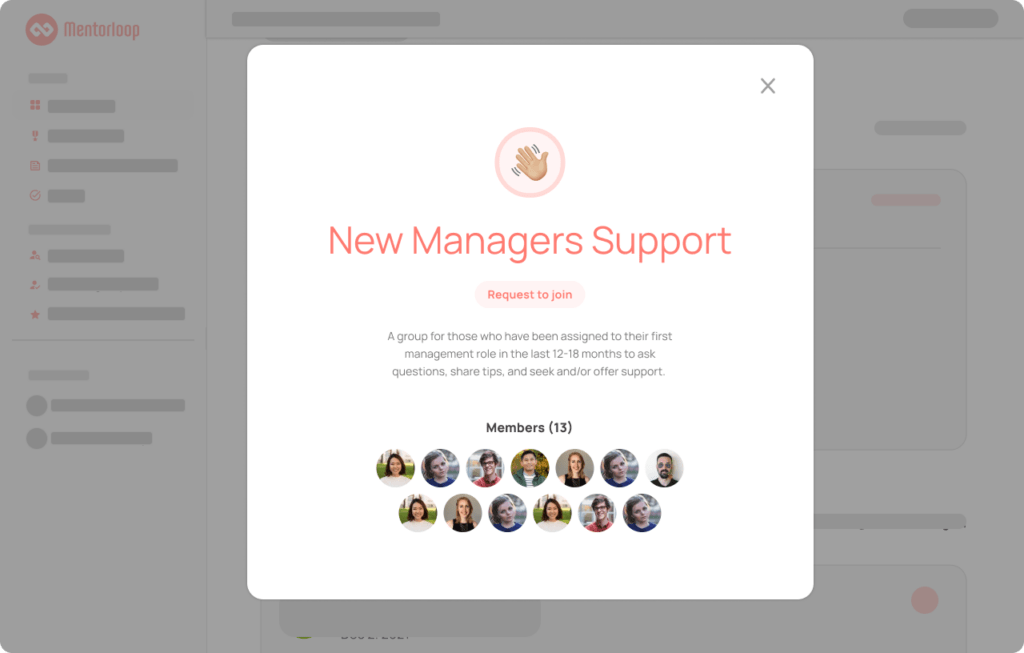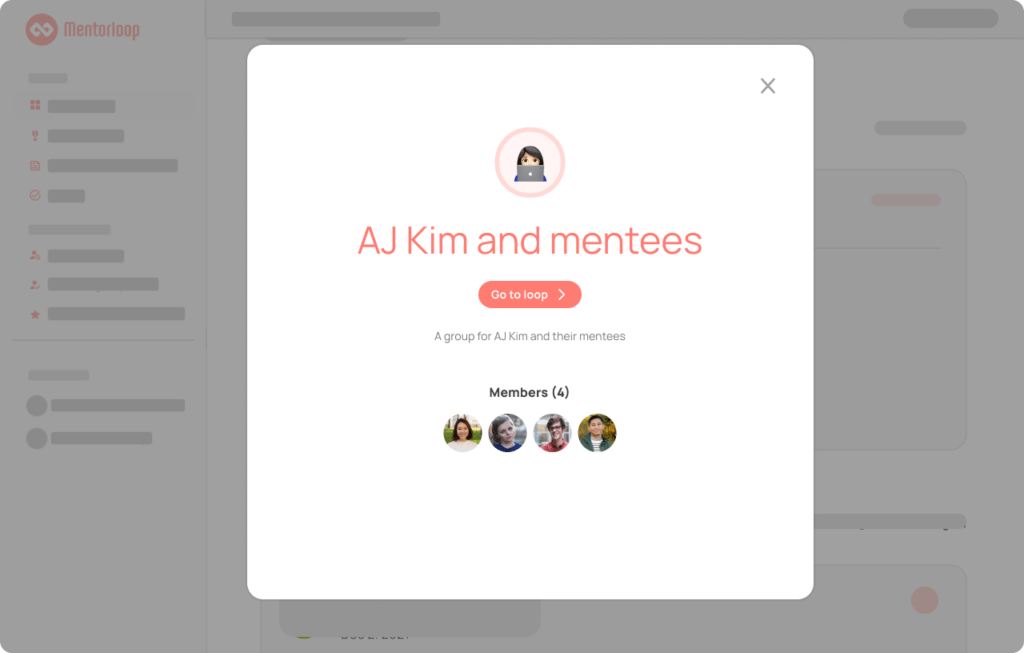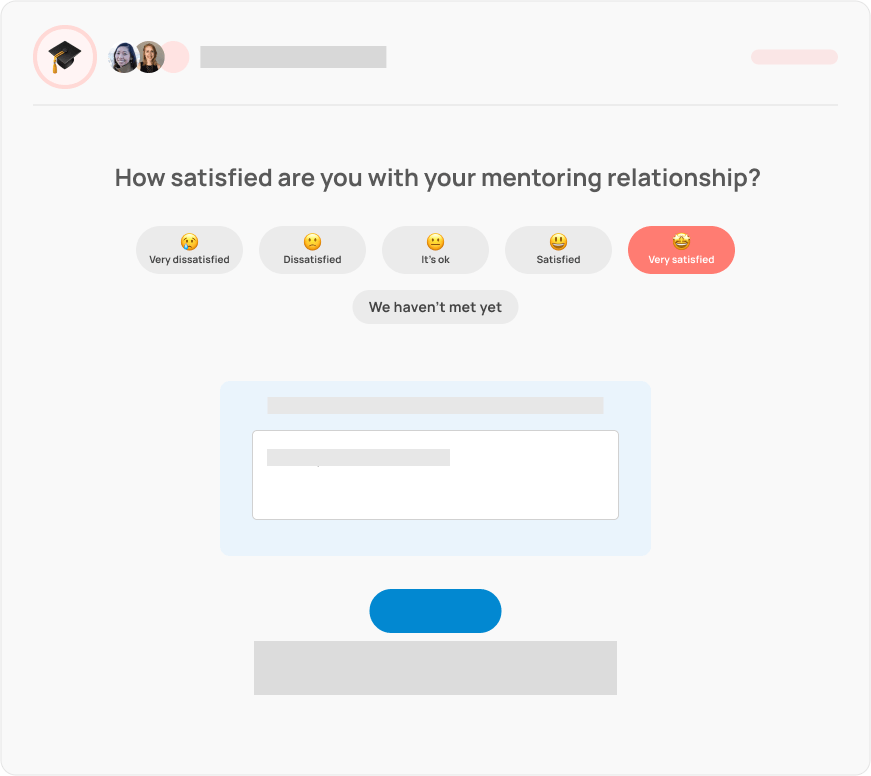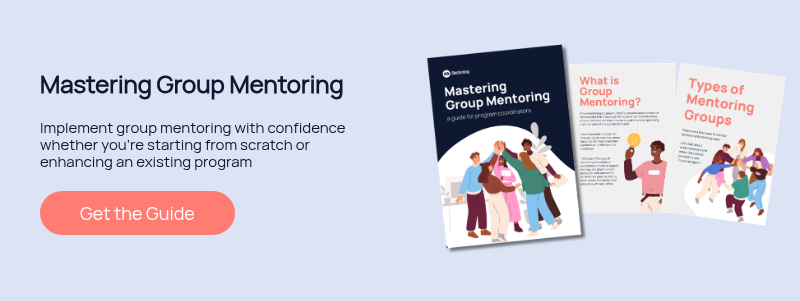What is Group Mentoring?
Group mentoring is a powerful tool for personal and professional development that involves gathering more than two individuals, often 4-10, with a common purpose or goal in mind and providing a mentor who acts as a guide and leader.
The focus of this type of mentoring is to create an environment of mutual support, learning, and growth, where people can help each other achieve their goals by sharing experiences, knowledge, and resources.
Understanding the Basics of Group Mentoring
Group mentoring is a structured process that involves regular meetings where the group members share their experiences, challenges, and successes. The mentor provides guidance, feedback, and support, but the group dynamics play a crucial role in shaping the development of the individuals.
It is a powerful tool for personal and professional growth, allowing individuals to learn from each other’s experiences, perspectives, and insights. It’s obvious, but this is what makes it so special – the group setting. It creates a supportive and collaborative environment where people can share their thoughts and ideas openly and honestly.
One of the benefits of group mentoring is the diversity of perspectives and experiences. The group members come from different backgrounds, industries, and levels of experience, which creates a rich and varied learning experience. Good group mentors leverage this diversity to facilitate discussions and activities that challenge assumptions, broaden perspectives, and foster creativity.
The mentor’s role in group mentoring is to create a safe and inclusive environment where everyone feels valued and respected, otherwise known as building psychological safety. The mentor should be able to facilitate productive conversations, encourage participation, resolve conflicts, and provide constructive feedback. Here, the mentor’s role is not to provide all the answers but to create an environment where people can discover their own solutions through reflection, discussion, and collaboration.
Group mentoring can also provide a sense of accountability and motivation. The group members can hold each other accountable for their goals and commitments, and the mentor can provide guidance and support to help them stay on track. The group dynamic can also provide motivation and inspiration, as individuals see their peers making progress and achieving their goals.

Benefits of Group Mentoring
Group mentoring provides several benefits for both the mentor and the mentees.
For mentees
For the mentees, group mentoring offers the opportunity to learn from multiple perspectives, network with peers, and build social skills. It also provides a safe space to express oneself, receive constructive feedback, and gain a sense of belonging.
It can also assist mentees in developing strong leadership skills. By working collaboratively with others, mentees learn how to effectively communicate, delegate tasks, and manage conflicts. They also learn how to motivate and inspire others, which can be valuable skills in their personal and professional lives – and of course, borrow learnings from their mentor’s experiences.
For mentors
For the mentor, group mentoring allows them to leverage their expertise to help multiple people and provides personal fulfilment from seeing the progress of the group as a whole. Mentors can also benefit from the insights and perspectives of mentees, which can help them stay current with industry trends and best practices.
More benefits
Group mentoring can also have long-term benefits such as increased retention, improved job satisfaction, and higher performance. In a group setting, members develop a support system that extends beyond the formal mentoring program, thereby creating a culture of continuous learning and development.
It can foster a sense of community and belonging within an organization, and mentees can build relationships with their peers and mentors, which can lead to increased engagement and loyalty to the company. This often translates into a more positive work environment and improves overall morale.
The Ideal Group Mentoring Structure
When it comes to determining the ideal group mentoring structure, there are a few factors to consider.
Group Access
First thing to consider is who has access to these groups. Depending on the purpose of a group, it may be wise to allow or restrict access to it.
For example, it makes sense to make a group specifically for a single mentor and their three mentees a hidden group but that wouldn’t make sense for a special interest group for first-time managers or international students. However, for a group that is dedicated to supporting new mentors, a program coordinator might want the ability to approve participants before they join the group.
On Mentorloop, you can choose whether a Group Loop is:
- Hidden (invite-only, this Group Loop cannot be seen by other participants),
- Private (available to browse but participants must be approved to join),
- or Public (participants can join freely).

Group Size
For instance, the size of each mentoring group can play a critical role in its success. A smaller group may allow for more personalized attention and deeper connections between members, while a larger group may offer more diverse perspectives and networking opportunities.
| Pros | Cons | |
| Small Group Loop | Allows for more personalized attention and deeper connections between members. | A lack of perspectives, experiences to share, or others to learn from. |
| Larger Group Loop | Offer more diverse perspectives and networking opportunities. | Personality factors play a larger role in the dynamic – extroverted vs introverted individuals. |
In our experience, the ideal group size depends on the type of group and its purpose. The key is to determine what the priority is for each mentoring group. Is it for building close rapport to eventually develop into more involved, one-to-one mentorships? Or is it to provide more broad networking opportunities to enrich existing mentoring relationships?
For example, for mentor-led groups wherein the purpose is to connect a mentor to their mentees, a group of 4-5 is great. It allows for diversity of thought among the mentees without it being too large for the mentor to handle.
However, for a dedicated peer support group that caters to an ERG, or for a special interest group for parents coming back from parental leave, a group of more than 10 participants is great – encouraged, even!
Participant Experience
Another important consideration is the group members’ level of experience and expertise. If the group consists of individuals who are relatively new to a particular field or industry, a more structured program with clear learning objectives and milestones may be beneficial. On the other hand, if the group is made up of seasoned professionals, a more flexible and open-ended approach may be appropriate.
Ultimately, the success of a group mentoring program depends on the needs and goals of the participants, as well as the skills and experience of the mentor. By taking the time to carefully consider these factors and tailor the program accordingly, you can create a mentoring experience that is both effective and rewarding for all involved.
Developing a Group Mentoring Program
Mentoring is a powerful tool for personal and professional development, and group mentoring programs can be especially effective in creating a supportive and collaborative environment for mentees. If you’re interested in developing a group mentoring program, here are some steps to consider to ensure its success:
| Step 1: Define Program Goals and Objectives | It’s important to define the goals and objectives of your program at the start. Consider what skills and knowledge you want mentees to gain, and how you want to measure success. You may also want to create a mission statement or guide your work. This will help you measure your outcomes. |
| Step 2: Design a Curriculum | With your goals and objectives in mind, you can start designing a curriculum that meets the needs of your mentees. Consider what topics you want to cover, and how you can accommodate for different learning and collaboration styles. |
| Step 3: Establish Meeting Logistics | Once you have a curriculum in place, you’ll need to establish meeting logistics. Determine how often you want to meet, and for how long. You’ll also need to decide on a meeting location, and whether you want to meet in person or virtually. If you’re meeting virtually, you’ll need to ensure that everyone has access to the necessary technology. Mentorloop integrates with all your favorite communication tools such as MS Teams, Slack, Zoom, and more – making group mentoring a breeze. |
| Step 4: Recruit Mentors and Mentees | After you have designed your mentoring program (Mentorloop makes this easy with Program Themes), you’ll need to recruit mentors and mentees. If you don’t already have a community or employee base to invite, reach out to your professional network, community organizations, and educational institutions to find potential participants. You can also advertise your program through social media, email lists, and word of mouth. |
| Step 5: Evaluate and Improve | As your program progresses, it’s important to evaluate its effectiveness and make improvements as needed. Solicit feedback from mentors and mentees, and use that feedback to refine your curriculum and meeting logistics. You may also want to track participant progress over time to measure the impact of your program. If you’re using Mentorloop, this is incredibly easy! The Mentorloop Sentiment feedback system takes care of short and sharp surveys, that are surfaced at the right time. No need to wait until the end of your program to learn who might need your support. |
By following these steps, you can create a group mentoring program that is engaging, effective, and sustainable.
Incorporating Group Loops Into An Existing Mentoring Program
Traditional one-on-one mentoring programs already offer invaluable guidance and support. But what if you could tap into the power of collaboration and peer learning to elevate your people’s mentoring experience? Incorporating groups into your existing program can create a richer learning environment, foster support networks, and allow mentors to reach a wider audience. It also offers your people more opportunities to build their Personal Advisory Boards. Here’s how to get started.
Building A Connected Community with Group Loops
Special Interest Groups
Create dedicated forums for participants to connect through shared experiences. This allows for ongoing discussion, knowledge sharing, and support rooted in similarities in circumstances. (e.g. working parents, international students, new managers, etc.) This is a great way to include and engage your organization’s Employee Resource Group (ERG) members and give them an additional avenue to collaborate and support each other.

Mentor-Led Groups
Many mentors choose to engage with a few mentees at a time. Giving them a platform to meet each other and exchange ideas in a group setting can give mentees a richer learning experience, not just from their mentor, but with their fellow mentees as well. It also has the benefit of giving your mentors a way to be more efficient with their time.

Boosting Learning Through Group Activities
Group Workshops
Organize sessions led by mentors or external experts covering relevant topics. This allows mentors to share knowledge efficiently and fosters peer learning.
Networking Events
Host social gatherings where mentees can connect with each other and their mentors in a casual setting. This builds camaraderie and allows for informal knowledge exchange.
Pro Tip: Use your groups to find out what events your cohort will enjoy or benefit from the most. You can even ask members to take part in selecting things like the activity or speaker.
Encouraging Peer Support with Group Structures
Peer Mentoring Circles
Create small groups of mentees with similar goals or challenges. These groups can meet regularly to discuss progress, offer support, and hold each other accountable, fostering a sense of community. For example, you can create a group specifically for those who want to be better at public speaking and presentations. This gives these participants a forum to give and get tips that others like them have used and found effective.
Mentor Support
You can create groups exclusive to your program’s mentors. This gives them a forum to ask questions, share experiences, and give advice to other mentors about managing and supporting their mentees.
Group Project Collaboration
Assign mentees a group project related to their development goals. This encourages teamwork, problem-solving, and knowledge sharing within the group, with mentors guiding the entire process. This can even be done within mentor-led groups as a collaboration exercise.
Remember:
- You can start small. If you’re unsure, begin with a pilot group to test the waters and gather feedback.
- Be intentional with the groups you create. Match participants with similar interests or goals to strengthen group connections.
- Facilitation matters. Designate someone to guide group discussions if needed This just gives your groups some structure, allowing participants to be more productive..
- Set clear expectations. Outline the purpose and format of group activities for smooth navigation.
- Feedback is key. Regularly ask participants for feedback to ensure the group component is enriching their experience.

If you’re running your program on Mentorloop, we take care of feedback collection for you! Mentorloop regularly asks your participants for feedback on their mentoring relationships, including their group mentoring relationships, so you can focus on acting on the feedback rather than collecting it.
By incorporating these strategies, you can offer your people more ways to learn, develop, and grow with more life-changing connections and give them more opportunities to build their Personal Advisory Board. In doing so, you can transform your traditional program into a dynamic ecosystem that fosters collaboration, peer support, and deeper learning for all participants.
Tips for Effective Group Mentoring
Effective group mentoring programs can have a significant impact on the lives of the mentees. However, they require an array of skills and strategies from the mentor. Below are some tips for effective group mentoring that can help mentors create a positive and productive mentoring experience:
Encouraging Active Participation
One of the most important aspects of group mentoring is encouraging active participation from all members. Mentors can do this by creating a welcoming and inclusive environment where everyone feels comfortable sharing their thoughts and ideas. They can also encourage participation by asking open-ended questions and soliciting feedback from all members. By doing so, mentors can help mentees build their confidence and feel more invested in the mentoring process.
Here are our tips on engaging your program’s mentors and mentees: How to Increase Mentoring Program Engagement
Creating a Safe, Inclusive Environment
Creating a safe and inclusive environment is critical to the success of group mentoring. Mentors should strive to create an environment where all members feel respected and valued, regardless of their backgrounds or experiences. They can do this by setting ground rules for respectful communication and behavior, and by addressing any instances of bullying or discrimination immediately. By creating a safe and inclusive environment, mentors can help mentees build trust and develop meaningful relationships with their peers.
Providing Constructive Feedback
Providing constructive feedback is an essential part of group mentoring. Mentors should aim to provide feedback that is specific, actionable, and focused on helping mentees achieve their goals. They should also be mindful of the mentee’s feelings and provide feedback in a way that is supportive and encouraging. By providing constructive feedback, mentors can help mentees identify areas for improvement and develop the skills they need to succeed.
Establishing Clear Goals and Expectations
Establishing clear goals and expectations is crucial to the success of group mentoring. Mentors should work with mentees to identify their goals and develop a plan for achieving them. They should also establish clear expectations for participation, attendance, and behavior. By setting clear goals and expectations, mentors can help mentees stay focused and motivated throughout the mentoring process.
Offering Relevant Resources and Support
Offering relevant resources and support is another important aspect of group mentoring. Mentors should provide mentees with access to resources such as books, articles, and online resources that are relevant to their goals and interests. They should also offer support and guidance as mentees navigate challenges and obstacles. By offering relevant resources and support, mentors can help mentees develop the skills and knowledge they need to succeed.
Mentorloop has you more than covered when it comes to quality mentoring content and resources. Your participants will have access to mentoring training as well as supportive content on the Mentorloop participant HelpHub and Academy, all of which you can surface on their dashboard’s Recommended Reading!
Enabling Growth and Development
Enabling growth and development is the ultimate goal of group mentoring. Mentors should strive to create an environment where mentees can learn, grow, and develop their skills and abilities. They should offer opportunities for mentees to practice new skills, take on leadership roles, and pursue their interests. By enabling growth and development, mentors can help mentees reach their full potential and achieve their goals.
Overall, effective group mentoring requires a range of skills and strategies from the mentor. By following these tips, mentors can create a positive and productive mentoring experience that has a lasting impact on the lives of the mentees.
Setting Clear Expectations in Group Mentoring
Setting clear expectations is the cornerstone of any successful group mentoring program. The mentor needs to establish guidelines and rules for the group members to ensure that everyone is on the same page. This will help to create a positive and productive environment for all involved.
One way to set clear expectations is to establish guidelines around meeting attendance. The mentor should communicate the importance of attending all meetings and make it clear that attendance is mandatory. This will help create a drum beat of activity, that ensures everyone is committed to the program and that the group can work together effectively.
Another important aspect of setting clear expectations is participation. The mentor should encourage all group members to actively participate in discussions and activities. This will help to create a sense of community within the group and will allow everyone to benefit from the mentorship experience.
Communication is also a key factor in setting clear expectations. The mentor should establish guidelines around how group members should communicate with one another and with the mentor. This can include setting up regular check-ins, creating a group chat or forum, or providing contact information for the mentor.
In addition to setting expectations around attendance, participation, and communication, the mentor should work with mentees to create goals for the group. These goals should be SMART: specific, measurable, achievable, relevant, and time-bound to ensure that they are meaningful and achievable.
For example, the mentor might set a goal for the group to complete a certain number of mentoring sessions within a specific timeframe. They might also create milestones for each session, such as completing a specific activity or discussing a particular topic.
By setting clear expectations and creating goals and milestones, the mentor can help to keep everyone motivated and accountable. This will help to ensure that the group is successful and that everyone benefits from the mentoring experience.
Challenges with Group Mentoring
Despite its many benefits, group mentoring can present several challenges. One of the biggest challenges is managing group dynamics, as personality conflicts, communication breakdowns, and power struggles can arise.
Other challenges may include lack of commitment, poor attendance, or resistance to change. The mentor should be prepared to address these challenges by establishing clear expectations, monitoring progress, and providing support and feedback when needed.
Learn more about the common reasons mentoring programs fall short
Regardless of the form it takes, effective group mentoring programs will require skilled mentors who understand the complexities of group dynamics, are committed to personal development, and are able to establish goals and expectations that align with the needs of the group members.
Group mentoring is a powerful tool for personal and professional development that provides a community of support, learning, and growth. The success of any group mentoring program relies on several factors, including a skilled mentor, clear goals, and a structured program that incorporates the appropriate resources and strategies to meet the needs of the group members.
Ready to unlock your people’s potential? Book a chat with one of our mentoring experts and find out how you can launch and run a group mentoring program with Mentorloop.





